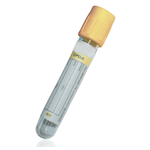Suitable Specimen Types
- Serum
- Li Hep Plasma
Sample Processing in Laboratory
Usual
Sample Preparation
Centrifuge - do not leave on cells overnight
Turnaround Time
1 daySample Stability
4°C once centrifuged
Potassium (serum)
General Information
Potassium is the main intracellular cation. Small changes in the distribution of potassium can give rise to medical emergencies. The serum and urine concentrations of potassium reflect a complex interplay of hormonal and other systems that regulate the intracellular content. The main regulators of potassium concentrations in serum and urine are, insulin, aldosterone, catecholamines and acid base status. Diseases of the kidney, adrenal and any process that affects acid base disturbance will affect plasma potassium concentration. Crush injuries are also a cause of hyperkalaemia.
High potassium concentrations can give rise to a medical emergency requiring rapid intervention. Changes in potassium concentration affect the electrical conductivity of muscles and cardiac muscle and in high concentrations can cause cardiac arrest.
Patient Preparation
None
Notes
Samples left on cells and haemolysed samples will not be analysed
Potassium can be artificially elevated by delayed centrifugation of samples. Interpret a raised potassium with caution if there has been a >6 hr delay between the sample being taken and received by the laboratory.
Exposure of whole blood to extremes of temperature affects potassium concetration. High temperatures lead to falsely low potassium results and low temperatures lead to falsely high results.
Note: Insulin, corticosteroids, furosemide, thiazides can decrease potassium. Potassium sparing diurectics, ACE inhibitors can increase potassium.
Reference Range
Adult 3.5-5.3 mmol/L
Plasma Potassium Paediatrics
Neonates (<4weeks) 3.4-6.0 mmol/L
Infant (<1yr) 3.5-5.7 mmol/L
1-16yrs 3.5-5.0 mmol/L
(Source : Pathology Harmony Recommendations)
Specifications
- EQA Scheme?: Yes
-
EQA Status:
NEQAS and WEQAS
